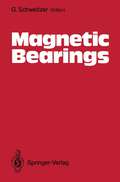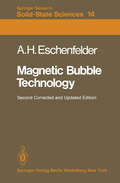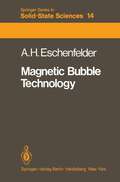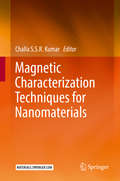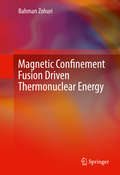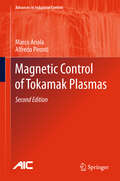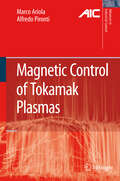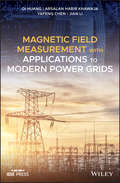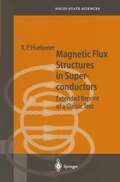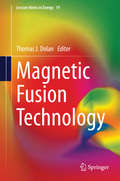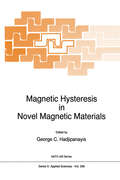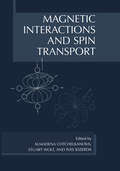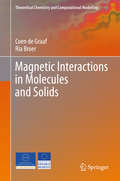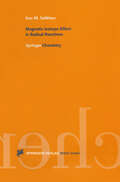- Table View
- List View
Magnetic Bearings: Theory, Design, and Application to Rotating Machinery
by H. Bleuler M. Cole P. Keogh R. Larsonneur E. Maslen R. Nordmann Y. Okada G. Schweitzer A. TraxlerCompiling the expertise of nine pioneers of the field, Magnetic Bearings - Theory, Design, and Application to Rotating Machinery offers an encyclopedic study of this rapidly emerging field with a balanced blend of commercial and academic perspectives. Every element of the technology is examined in detail, beginning at the component level and proceeding through a thorough exposition of the design and performance of these systems. The book is organized in a logical fashion, starting with an overview of the technology and a survey of the range of applications. A background chapter then explains the central concepts of active magnetic bearings while avoiding a morass of technical details. From here, the reader continues to a meticulous, state-of-the-art exposition of the component technologies and the manner in which they are assembled to form the AMB/rotor system. These system models and performance objectives are then tied together through extensive discussions of control methods for both rigid and flexible rotors, including consideration of the problem of system dynamics identification. Supporting this, the issues of system reliability and fault management are discussed from several useful and complementary perspectives. At the end of the book, numerous special concepts and systems, including micro-scale bearings, self-bearing motors, and self-sensing bearings, are put forth as promising directions for new research and development. Newcomers to the field will find the material highly accessible while veteran practitioners will be impressed by the level of technical detail that emerges from a combination of sophisticated analysis and insights gleaned from many collective years of practical experience. An exhaustive, self-contained text on active magnetic bearing technology, this book should be a core reference for anyone seeking to understand or develop systems using magnetic bearings.
Magnetic Bearings: Proceedings of the First International Symposium, ETHG Zurich, Switzerland, June 6–8, 1988
by G. SchweitzerMagnetic Bearings are bearings where the suspension forces are generated magnetically without any contact. The advantages to modern machinery are obvious: no mechanical wear, no lubrication, potential for high rotor speed, accuracy, and high dynamic performance, new constructional solutions to a classical problem in machine dynamics. The realization of such bearings is in rapid progress. Examples for application areas are turbomachinery, centrifuges, vacuum techniques, machine tool spindles, chemical industry, medical devices, robotics, high speed drives, spacecraft equipment, con tactless actuators, vibration isolation. The Symposium is demonstrating the current state of the art in this developing field of mechatronics, showing actual research efforts, reporting on applications in the various areas, and discussing open questions. The main purpose of the Symposium has been to establish a common information basis for people working on magnetic bearings. It will point to promising areas, and it will help to facilitate decisions on research and development projects, and on investments for applications.
Magnetic Bubble Technology (Springer Series in Solid-State Sciences #14)
by A. H. EschenfelderThe popularity of the First Edition of this book has been very gratifying. It confirms that there is a genuine need for a text covering the magnetic bubble technology. We are pleased that the readers have found that this book satisfies that need. It has been used as a text for courses in both universities and industry, and as a reference manual by workers active in the field. To meet the need for more copies of the book it seemed preferable to publish a second edition rather than merely a second printing. There has been some significant progress, even in the short time since the initial printing, and we wanted to include that. At the same time we would like to provide the new copies at the lowest possible cost so that they are more easily obtained by students. For this reason the new edition is in soft cover and the recent progress has been described in a final chapter rather than incorporated into the original chapters. This eliminates the expense of resetting and repaging the original text. At the same time up-to-date references have been added and typographical errors have been corrected in the original chapters. It is our hope that this edition will be useful to those with an interest in the fascinating field of magnetic bubbles.
Magnetic Bubble Technology (Springer Series in Solid-State Sciences #14)
by A. H. EschenfelderMagnetic bubbles are of interest to engineers because their properties can be used for important practical electronic devices and they are of interest to physicists because their properties are manifestations of intriguing physical principles. At the same time, the fabrication of useful configurations challenges the materials scientists and engineers. A technology of magnetic bubbles has developed to the point where commercial products are being marketed. In addition, new discovery and development are driving this technology toward substantially lower costs and presumably broader application. For all of these reasons there is a need to educate newcomers to this field in universities and in industry. The purpose of this book is to provide a text for a one-semester course that can be taught under headings of Solid State Physics, Materials Science, Computer Technology or Integrated Electronics. It is expected that the student of anyone of these disciplines will be interested in each of the chapters of this book to some degree, but may concentrate on some more than others, depending on the discipline. At the end of each chapter there is a brief summary which will serve as a reminder of the contents of the chapter but can also be read ahead of time to determine the depth of your interest in the chapter.
Magnetic Characterization Techniques for Nanomaterials
by Challa S.S.R. KumarSixth volume of a 40 volume series on nanoscience and nanotechnology, edited by the renowned scientist Challa S.S.R. Kumar. This handbook gives a comprehensive overview about Magnetic Characterization Techniques for Nanomaterials. Modern applications and state-of-the-art techniques are covered and make this volume an essential reading for research scientists in academia and industry.
Magnetic Communications: From Theory to Practice
by Fei HuThis book covers comprehensively the theories and practical design of magnetic communications. It emphasizes the differences between it and RF communications. It first provides the models and signal propagation principles of magnetic communication systems. Then it describes the hardware architecture of the system, including transmitter, MODEM, inductors, coils, etc. Then, it discusses the corresponding communication software design principles and cases. Finally, it presents several types of practical implementations and applications.
Magnetic Communications: From Theory to Practice
by Fei HuThis book covers comprehensively the theories and practical design of magnetic communications. It emphasizes the differences between it and RF communications. It first provides the models and signal propagation principles of magnetic communication systems. Then it describes the hardware architecture of the system, including transmitter, MODEM, inductors, coils, etc. Then, it discusses the corresponding communication software design principles and cases. Finally, it presents several types of practical implementations and applications.
Magnetic Components: Basics and applications
by Peter ZachariasThe book deals with methods for the description and design of electromagnetic components. Both linear and nonlinear components are covered. For electrical simulations the necessary equivalent circuit diagrams are derived and a general methodology is developed. Possible influences on properties via material selection, winding design and premagnetisation of sections are treated. Measurement characterization, modeling, possible errors and model limits are dealt with extensively. In the last chapter examples are discussed.
Magnetic Components for Power Electronics
by Alex GoldmanMagnetic Components for Power Electronics concerns the important considerations necessary in the choice of the optimum magnetic component for power electronic applications. These include the topology of the converter circuit, the core material, shape, size and others such as cost and potential component suppliers. These are all important for the design engineer due to the emergence of new materials, changes in supplier management and the examples of several component choices. Suppliers using this volume will also understand the needs of designers. Highlights include: Emphasis on recently introduced new ferrite materials, such as those operating at megahertz frequencies and under higher DC drive conditions; Discussion of amorphous and nanocrystalline metal materials; New technologies such as resonance converters, power factors correction (PFC) and soft switching; Catalog information from over 40 magnetic component suppliers; Examples of methods of component choice for ferrites, amorphous nanocrystalline materials; Information on suppliers management changes such as those occurring at Siemens, Philips, Thomson and Allied-Signal; Attention to the increasingly important concerns about EMI. This book should be especially helpful for power electronic circuit designers, technical executives, and material science engineers involved with power electronic components.
Magnetic Confinement Fusion Driven Thermonuclear Energy
by Bahman ZohuriThis book covers the principles and practices behind the Magnetic Confinement Fusion (MCF) approach to driven new source of energy. All possible technical methods, including well established theoretical research, as well as findings tested in an experimental tokamak reactor, are examined in order to determine how to best achieve breakeven via this pathway to plasma-driven fusion. The author undertakes a life cycle analysis to compare and contrast the efficiency, environmental impacts, and operating costs of plasma-driven MCF fusion against other forms of energy generation currently in widespread use. The associated computer code and numerical analysis are included in the book. No prior knowledge of MCF and no more than basic background in plasma physics is required.
Magnetic Control of Tokamak Plasmas (Advances in Industrial Control)
by Marco Ariola Alfredo PirontiThis book is a complete treatment of work done to resolve the problems of position-, current-, and shape-control of plasma in tokamak-type (toroidal) devices being studied as a potential means of commercial energy production by nuclear fusion. Modelling and control are both detailed, allowing non-expert readers to understand the control problem. Starting from the magneto-hydro-dynamic equations, all the steps needed for the derivation of plasma state-space models are enumerated with frequent recall of the basic concepts of electromagnetics. The control problem is then described, beginning with the control of current and position—vertical and radial—control and progressing to the more challenging shape control. The solutions proposed vary from simple PIDs to more sophisticated MIMO controllers.The second edition of Magnetic Control of Tokamak Plasmas contains numerous updates and a substantial amount of completely new material covering areas such as:• modelling and control of resistive wall modes—the most important non-axisimmetric mode;• the isoflux approach for shape control; • a general approach for the control of limiter plasmas;• the use of inner vessel coils for vertical stabilization; and• significantly enhanced treatment of plasma-shape control at JET, including experimental results and introducing a method implemented for operation in the presence of current saturations.Whenever possible, coverage of the various topics is rounded out with experimental results obtained on currently existing tokamaks. The book also includes a presentation of the typical actuators and sensors used for control purposes in tokamaks. Some mathematical details are given in the appendices for the interested reader.The ideas formulated in this monograph will be of great practical help to control engineers, academic researchers and graduate students working directly with problems related to the control of nuclear fusion. They will also stimulate control researchers interested more generally in the advanced applications of the discipline.Advances in Industrial Control aims to report and encourage the transfer of technology in control engineering. The rapid development of control technology has an impact on all areas of the control discipline. The series offers an opportunity for researchers to present an extended exposition of new work in all aspects of industrial control.
Magnetic Control of Tokamak Plasmas (Advances in Industrial Control)
by Marco Ariola Alfredo Pirontithis part is supported by two useful appendices on some of the mathematical tools used and the physical units of plasma physics. State-space models, state observers, H control, and process simulations are some of the familiar techniques used by ? the authors to meet the demanding spatial control specifications for these processes; however, the research reported in the monograph is more that just simulation studies and proposals for possible future hypothetical controllers, for the authors have worked with some of the world’s leading existing tokamak facilities. Chapter 5, 8, and 9 respectively, give practical results of implementations of their control schemes on the FTU Tokamak (Italy), the TCV Tokamak (Switzerland), and the JET Tokamak (United Kingdom). Additionally, the authors present simulation results of their ideas for the control of the new tokamak proposed for the ITER project. In conclusion, being very aware that most control engineers will not be conversant with the complexities of tokamak nuclear fusion reactor control, the authors have taken special care to give a useful introduction to the background of nuclear fusion, the science of plasma physics and appropriate models in the first part of the monograph (Chapters 1 to 3). This introduction is followed by six chapters (4 to 9) of control studies. In Chapter 4, the generic control problem is established and then five case study chapters follow.
Magnetic Core Selection for Transformers and Inductors: A User's Guide to Practice and Specifications, Second Edition (Electrical and Computer Engineering)
by Colonel Wm. McLymanWritten as a companion to Transformer and Inductor Design Handbook (second ed), this work compiles the specifications of over 12,000 industrially available cores and brings them in line with standard units of measurement, simplifying the selection of core configurations for the design of magnetic components.
Magnetic Domains: The Analysis of Magnetic Microstructures
by Alex Hubert Rudolf SchäferThis book offers systematic and up-to-date treatment of the whole area of magnetic domains. It contains many contributions that have not been published before. The comprehensive survey of this important area gives a good introduction to students and is also interesting to researchers.
Magnetic Electron Lenses (Topics in Current Physics #18)
by P. W. HawkesNo single volume has been entirely devoted to the properties of magnetic lenses, so far as I am aware, although of course all the numerous textbooks on electron optics devote space to them. The absence of such a volume, bringing together in formation about the theory and practical design of these lenses, is surprising, for their introduction some fifty years ago has created an entirely new family of commercial instruments, ranging from the now traditional transmission electron microscope, through the reflection and transmission scanning microscopes, to co lumns for micromachining and microlithography, not to mention the host of experi mental devices not available commercially. It therefore seemed useful to prepare an account of the various aspects of mag netic lens studies. These divide naturally into the five chapters of this book: the theoretical background, in which the optical behaviour is described and formu lae given for the various aberration coefficients; numerical methods for calculat ing the field distribution and trajectory tracing; extensive discussion of the paraxial optical properties and aberration coefficients of practical lenses, il lustrated with curves from which numerical information can be obtained; a comple mentary account of the practical, engineering aspects of lens design, including permanent magnet lenses and the various types of superconducting lenses; and final ly, an up-to-date survey of several kinds of highly unconventional magnetic lens, which may well change the appearance of future electron optical instruments very considerably after they cease to be unconventional.
Magnetic Field Assisted Finishing: Methods, Applications and Process Automation (Advanced Manufacturing Techniques)
by Dilshad Ahmad Khan Zafar Alam Faiz IqbalThis comprehensive reference text discusses the concepts of the magnetic field assisted finishing processes that range from working principles, material removal mechanisms, process parameters and equipment involved, to the industry-specific applications. The book discusses various aspects of surface finishing, including types of material to be finished, types of finishing abrasives and their characteristics for material compatibility, that are different from process-specific details. It covers important concepts, including magnetic abrasive finishing (MAF), magnetorheological finishing (MRF) and magnetorheological abrasive flow finishing (MRAFF). Features Discusses a wide range of magnetic field assisted finishing processes in a comprehensive manner Covers different process parameters by considering their effects on the finishing output Provides process limitations to achieve optimal yield Offers numerical explanations for better selection of process parameters Discusses automation of processes with state-of-the-art technologies This book is aimed at graduate students and professionals in the fields of mechanical engineering, aerospace engineering, production engineering, manufacturing and industrial engineering.
Magnetic Field Assisted Finishing: Methods, Applications and Process Automation (Advanced Manufacturing Techniques)
by Dilshad Ahmad Khan Zafar Alam Faiz IqbalThis comprehensive reference text discusses the concepts of the magnetic field assisted finishing processes that range from working principles, material removal mechanisms, process parameters and equipment involved, to the industry-specific applications. The book discusses various aspects of surface finishing, including types of material to be finished, types of finishing abrasives and their characteristics for material compatibility, that are different from process-specific details. It covers important concepts, including magnetic abrasive finishing (MAF), magnetorheological finishing (MRF) and magnetorheological abrasive flow finishing (MRAFF). Features Discusses a wide range of magnetic field assisted finishing processes in a comprehensive manner Covers different process parameters by considering their effects on the finishing output Provides process limitations to achieve optimal yield Offers numerical explanations for better selection of process parameters Discusses automation of processes with state-of-the-art technologies This book is aimed at graduate students and professionals in the fields of mechanical engineering, aerospace engineering, production engineering, manufacturing and industrial engineering.
Magnetic Field Measurement with Applications to Modern Power Grids (Wiley - IEEE)
by Qi Huang Arsalan Habib Khawaja Yafeng Chen Jian LiA comprehensive review of the development, challenges and utilisation of magnetic field measurement Magnetic Field Measurement with Applications to Modern Power Grids offers an authoritative review of the development of magnetic field measurement and the application of the technology to the smart grid. The authors, noted experts in the field, present the challenges to the field of magnetics and explore the use of cutting-edge magnetic technology in the development of the smart grid. In addition, the authors discussed the applications of magnetic field measurements in substations, generations systems, transmission systems and distribution systems. The specialized applications of magnetic field measurements in these venues are explored including the typical sensors used, the field strength levels and spectral frequencies involved and the mathematics that are needed to process data measurements. The book presents the complex topic of electromagnetics in clear and understandable terms. Magnetic Field Measurement with Applications to Modern Power Grids offers researchers in the magnetic community a guide to the progress of the smart grid and helps to inspire innovation of magnetic technologies in the smart grid. The technologies of measurement are a bridge between mathematical models and application oriented practice. The book is a guide to that bridge and: Offers a comprehensive review of the development of magnetic field measurement Shows how magnetic field measurement applies to the smart grid Outlines the challenges, trends and needs for future magnetic measurement systems Includes information on the need for levels of standardisation, smart grid applications and innovative sensors Written for researchers in smart grid, power engineers, power grid companies and professionals in the measurement and test industries, Magnetic Field Measurement with Applications to Modern Power Grids is an authoritative guide that offers a clear understanding of the relationship between the magnetic field measurement and power grids.
Magnetic Field Measurement with Applications to Modern Power Grids (Wiley - IEEE)
by Qi Huang Arsalan Habib Khawaja Yafeng Chen Jian LiA comprehensive review of the development, challenges and utilisation of magnetic field measurement Magnetic Field Measurement with Applications to Modern Power Grids offers an authoritative review of the development of magnetic field measurement and the application of the technology to the smart grid. The authors, noted experts in the field, present the challenges to the field of magnetics and explore the use of cutting-edge magnetic technology in the development of the smart grid. In addition, the authors discussed the applications of magnetic field measurements in substations, generations systems, transmission systems and distribution systems. The specialized applications of magnetic field measurements in these venues are explored including the typical sensors used, the field strength levels and spectral frequencies involved and the mathematics that are needed to process data measurements. The book presents the complex topic of electromagnetics in clear and understandable terms. Magnetic Field Measurement with Applications to Modern Power Grids offers researchers in the magnetic community a guide to the progress of the smart grid and helps to inspire innovation of magnetic technologies in the smart grid. The technologies of measurement are a bridge between mathematical models and application oriented practice. The book is a guide to that bridge and: Offers a comprehensive review of the development of magnetic field measurement Shows how magnetic field measurement applies to the smart grid Outlines the challenges, trends and needs for future magnetic measurement systems Includes information on the need for levels of standardisation, smart grid applications and innovative sensors Written for researchers in smart grid, power engineers, power grid companies and professionals in the measurement and test industries, Magnetic Field Measurement with Applications to Modern Power Grids is an authoritative guide that offers a clear understanding of the relationship between the magnetic field measurement and power grids.
Magnetic Flux Structures in Superconductors: Extended Reprint of a Classic Text (Springer Series in Solid-State Sciences #6)
by R.P. HuebenerThis second edition has been brought up to date by the inclusion of an extensive new chapter on aspects relevant to high-temperature superconductors. The new edition provides researchers, engineers and other scientists with an introduction to the field and makes useful supplementary reading for graduate students in low-temperature physics.
Magnetic Fusion Technology (Lecture Notes in Energy #19)
by Thomas J. DolanMagnetic Fusion Technology describes the technologies that are required for successful development of nuclear fusion power plants using strong magnetic fields. These technologies include: • magnet systems, • plasma heating systems, • control systems, • energy conversion systems, • advanced materials development, • vacuum systems, • cryogenic systems, • plasma diagnostics, • safety systems, and • power plant design studies. Magnetic Fusion Technology will be useful to students and to specialists working in energy research.
Magnetic Hysteresis in Novel Magnetic Materials (NATO Science Series E: #338)
by G. C. HadjipanayisA detailed presentation of the physics of the various hysteresis models that are currently used to explain the magnetization reversal process, including coherent and incoherent magnetization processes, micromagnetism and its application in thin films, multilayers, nanowires, particles and bulk magnets, domain wall pinning and domain wall dynamics, and Preisach modelling. Some of the faulty concepts and interpretations that still exist in the literature are rectified. Magnetic imaging techniques are reviewed, including TEM, SEM, magnetic force microscopy, and optical microscopy. Temperature, field and angular dependence of coercivity, magnetic interactions and magnetic phenomena are reviewed and their effect on magnetic hysteresis is discussed. The magnetic properties of novel materials are discussed, including nanoparticles, nanocrystalline granular solids, particulate media, thin films, and bulk magnets. Finally, present and future applications of novel materials are presented, including magnetic and magneto-optic recording media, magneto-electronics, sensors, magnetic circuit design, and novel structures created from rigid, high-energy permanent magnets.
Magnetic Interactions and Spin Transport
by Almadena Chtchelkanova Stuart A. Wolf Yves IdzerdaStuart Wolf This book originated as a series of lectures that were given as part of a Summer School on Spintronics in the end of August, 1998 at Lake Tahoe, Nevada. It has taken some time to get these lectures in a form suitable for this book and so the process has been an iterative one to provide current information on the topics that are covered. There are some topics that have developed in the intervening years and we have tried to at least alert the readers to them in the Introduction where a rather complete set of references is provided to the current state of the art. The field of magnetism, once thought to be dead or dying, has seen a remarkable rebirth in the last decade and promises to get even more important as we enter the new millennium. This rebirth is due to some very new insight into how the spin degree of freedom of both electrons and nucleons can play a role in a new type of electronics that utilizes the spin in addition to or in place of the charge. For this new field to mature and prosper, it is important that students and postdoctoral fellows have access to the appropriate literature that can give them a sound basis in the funda mentals of this new field and I hope that this book is a very good start in this direction.
Magnetic Interactions in Molecules and Solids (Theoretical Chemistry and Computational Modelling)
by Coen de Graaf Ria BroerThis textbook is the second volume in the Theoretical Chemistry and Computational Modeling series and aims to explain the theoretical basis of magnetic interactions at a level that will be useful for master students in physical, inorganic and organic chemistry.The book gives a treatment of magnetic interactions in terms of the phenomenological spin Hamiltonians that have been such powerful tools for chemistry and physics in the past half century, starting from the simple Heisenberg and Ising Hamiltonians and ending with Hamiltonians that include biquadratic, cyclic or anisotropic exchange. On the other hand, it also explains how quantum chemical methods, reaching from simple mean field methods to accurate models that include the effects of electron correlation and spin-orbit coupling, can help to understand the magnetic properties. Connecting the two perspectives is an essential aspect of the book, since it leads to a deeper understanding of the relation between physical phenomena and basic properties. It also makes clear that in many cases one can derive magnetic coupling parameters not only from experiment, but also from accurate ab initio calculations.The book starts with introducing a selection of basic concepts and tools. Throughout the book the text is interlarded with exercises, stimulating the students to not only read but also verify the assertions and perform (parts of) the derivations by themselves. In addition, each chapter ends with a number of problems that can be used to check whether the material has been understood.
Magnetic Isotope Effect in Radical Reactions: An Introduction
by Kev M. SalikhovIn the last two decades it was demonstrated that, in addition to masses and charges, magnetic moments of nuclei are able to influence remarkably chemical reactions. This book presents the physical background (both theoretical and experimental) of the magnetic isotope effects in radical reactions in solutions. Special attention has been paid to the quantitative interpretation of the available experimental data. This book will be useful for physicists, chemists and biologists employing the isotope effect in their investigations as well as for those involved in isotope separation and isotope enrichment projects. Additionally, the magnetic isotope effect appears to be important in geochemistry and cosmochemistry. The book can be recommended for postgraduates and senior undergraduate students.

